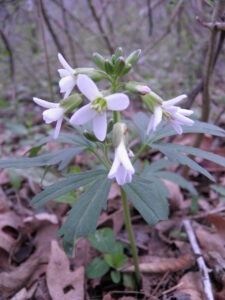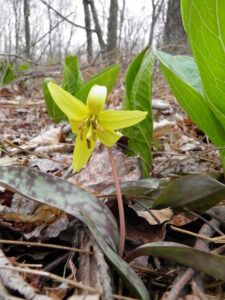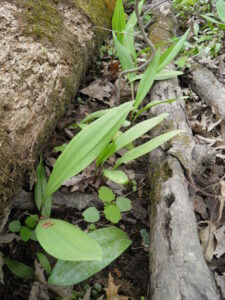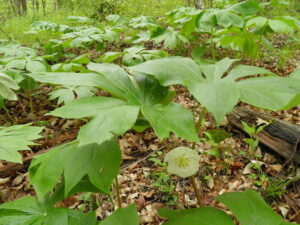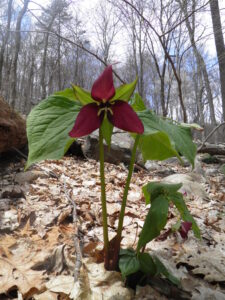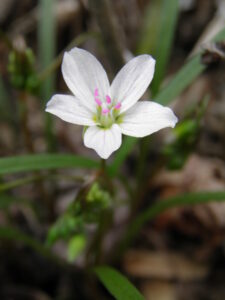As Spring arrives the fields and woodlands begin to wake-up and burst with the emergence of plant life to color the landscape and welcome in the wildlife from the long cold winter. And with the arrival of the new buds, shoots and flowers comes opportunity for us humans to embrace the outdoors and our primal roots and forage!
The concept of foraging it is an excellent way to engage and educate oneself about the importance of natural resource protection, habitat, and connections between organisms. Knowing where your food comes from, linking the food to the land, creates better education opportunities for people to recognize how conservation efforts protect soil, water, wildlife, and other natural resources.
Where our food comes from and how it is grown (be it on a farm or in nature) has a profound effect on our landscapes, our health, our wildlife, and the communities where we live. And how we steward and manage our lands and understand the connections these plants have on an ecosystem is the key to a meaningful, healthy, and enjoyable existence.
However, not all plants may be suitable to forage. Just because it appears in an edible wild plant book, cookbook or website or are being offered for sale for consumption does not always make that plant fair game to forage. Obviously, plants that appear in Federal and State Endangered or Threatened species list should not be foraged, but what about other native plants that serve ecological niches in ecosystems. Some of these plants might seem “abundant” in a particular area, but those plants also fill very special functions on the landscape that have direct impact on other species and help maintain ecological balance in the landscape. Specifically, certain native plants called Spring ephemerals.
Spring ephemerals are found throughout the eastern United States and Canada, usually close to the ground in woodlands and floodplains. Examples of spring ephemerals in the Northeast include: Trout lily (Erythronium americanum), Spring beauty (Claytonia virginica), Cut-leaf toothwort (Cardamine concatenata), May-apple (Podophyllum peltatum), Wild leeks (AKA Ramps) (Allium tricoccum) and various Trilliums (Trillium spp.) to name a few.
Spring ephemerals have a unique growing strategy. They begin to show them themselves above ground during a very small window where the trees do not yet have leaves and they can receiver maximum sunlight. In this short timeframe of a few weeks out of the entire year, the spring ephemeral must grow, leaf-out, flower, be pollinated, produce seeds, and die back. By May or June when the trees and shrubs overhead have fully leafed-out and block access to the sunlight the Spring ephemerals have retreated underground until they emerge again the following year.
Spring ephemerals serve many ecological purposes including providing vital early spring food sources for many beneficial insects when food sources are limited. This is of particular importance to various essential pollinators such as bees, bee flies and butterflies. According to the National Academy of Sciences, close to 75% of the flowering plants on earth rely to some degree on pollinators in order to set seed or fruit. From these plants comes one-third of humankind’s food and even greater proportion of the food for much of our wildlife. When you consider how limited early spring food sources are in the landscape for these pollinators, one may re-think foraging for a spring ephemeral, no matter if it just taking a few or many.
Another function spring ephemerals serve is being the main subject of a process called myrmecochory. Myrmecochory is seed dispersal by ants. Spring ephemeral seeds have fatty external appendages called eliaosomes. These elaiosomes attract ants that will carry the seeds back to their nests to feed their young. However, once the eliaosmes are eaten the remaining seeds have now been transported to another location to start to germinate to grow another generation of spring ephemeral.
Reports have shown that a single ant colony may collect as many as a thousand seeds over a season. However, although many seeds are collected and transported, the transportation of the seed on average in not that far, only on average of about 6 feet. Because offspring remain so local (unlike plants dispersed by wind, larger animals, birds), removal of plants from an area is major threat to the survival of spring ephemerals because once these plants are gone from the forest, it is rare that they return because the seed source is removed.
Spring ephemerals are declining in many areas due to development (urbanization and sprawl) climate change, spread of invasive species and deer browse. Because of their fragile beauty, spring ephemerals are also tempting to being picked for their flowers. Disturbance to these plants, especially digging them out, can severely disturb or kill the slow-growing rootstocks of the ones that remain on the landscape.
So, leave these plants and enjoy their fragile beauty in nature where they belong. If you need to pick, then be responsible and choose some lovely but robust non-native invasive/exotic plants or noxious weeds which are not as connected to the underlying landscape ecosystem and which are aggressively prolific.
Remember, sustainable management of natural resources is essential to make ecosystems functional, as well as food systems sustainable.


